Demons of Batalanda: Who was behind them?
Posted on December 29th, 2017
By Dharman Wickremaratne
It was the time when terror enveloped the whole of Sri Lanka. The JVP’s second insurgency was raging. Many were the sacrifices made to appease the demons in human form. They were celebrating and enjoying life while murder squads under their direction were roaming the country looking for prey.
Torture chambers were setup at different places. People died by the thousands after suffering brutal torture. Bodies of victims were seen everywhere. They were burnt or dumped in rivers and canals. The buildings which housed the torture chambers were (1) state institutions, (2) private houses which were rented (3) public places and (4) housing complexes.
Outside Colombo the infamous ones were at Eliyakanda Matara, Pelawatte, Mahaweli Housing Scheme opposite the Embilipitiya National School, Soranatota Estate Kalutara, Walawwatta Galle, Community Centre Angunukolapelessa, Ekanayake Medirigiriya, Pelvehera Government Farm Dambulla, Haliela Motors Garage Badulla, Polwatte Chilaw, Weligama Camp, Thalalla Workers Vocational Training Centre Matara, Hilltop Galle, Kotigala Galle, Unagaswala Karandeniya, Bombuwala Kalutara, Siyambalanduwa Monaragala, Muthukandiya Project office near 4th Mile Post Ampara, Polgolla Cooperative School, Batheegama Estate, Wickramasinghe Bangalow Kegalle, Beragala Summer Fashion Garment Factory Haputale, Nuwara Eliya Town Hall, near the Syambala tree across the river close to the Pallekela Camp (today a hotel has come up there), Wehera Kurunegala and Lindula Tea Factory among other places.
Remembering the dead and the missing.
The torture chambers in and around Colombo included Yataro Cafeteria, Thunmulla Colombo, Racecourse Grounds Colombo, Batalanda at Sapugaskanda Biyagama, Sethsiripaya Battaramulla, Steel Corporation Training Centre Oruwala, Colombo University’s Law Faculty, Government Offices in Torrington Square and Gregory Road Colombo, Kelaniya University sports building, Mattegoda Camp, Youth Centre Mirigama, Pattiya Junction Peliyagoda, Kesbewa, cattle shed Dematagoda, General Cemetery Borella, Golf Grounds Model Farm Road, Jayewardenapura Hostel, Management Building Jayewardenepura University, Henry Pedris Sports Pavillion Havelock Town, Tyronne Fernando Sports Pavillion Moratuwa and the Billiard Hall Pattiya Junction Kelaniya.
Among the most notorious torture chambers was the one at Batalanda. It was in a 20-acre coconut plantation in the Biyagama Electorate in the Gampaha District.After the State Fertiliser Corporation was established a British Company was given the contract to set up a urea production plant in a block of land at Sapugaskande. Since the foreign technical experts engaged in the project were expected to stay in Sri Lanka for a considerable period the Batalanda Housing Scheme was built, which is located two kilometres off the junction on the Kiribathgoda-Biyagama Road. The housing scheme comprised 64 different types housing units, an office complex, and a section for a club and a swimming pool.
Ranil Wickramesinghe.
Since Fertiliser Corporation was continuously suffering loses the Government decided to close it down on a proposal made by Industries Minister Cyril Mathew in 1984. But the foreign company which assisted in establishing the corporation did not welcome the decision. Again in 1986 the then Industries Minister Denzil Fernando gave Asoka Senanayake the power to terminate its operations. The foreign technicians who were occupying the housing complex left Sri Lanka during the first half of the 1980s. Thereafter senior government officials came to occupy some of the housing units there. Others were rented out to Ceylon Electricity Board officials and the officials of a private security firm. Another section was officially released to the military in 1985 for setting up an Army camp.
It did not take long for the horrors of Batalanda to be heard across the Kelani Valley. The torturers and murderers were enjoying political patronage but their crimes unexpectedly came to public attention when several detainees escaped from the place leading to legal action.
The PA Government which came to power in 1994 appointed a Presidential Commission to investigate the incidents at Batalanda. The commission probed the running of the illegal detention centre and torture chamber at the Batalanda housing complex from January 1, 1988 to December 31, 1990. The Commission began its sittings under Appeal Court Judge Justice Dharmasiri Jayawickrema at the Colombo High Court on September 21, 1995. The other Commission member was Appeal Court Judge, Justice Nimal Dissanayake. Sri Lanka Bar Association’s Human Rights Committee Chairman (1996) R.I. Obeysekera participated in an advisory capacity.
Then IGP Ernest Perera, Senior SP Nalin Delgoda (then a sub-inspector), SSP Douglas Peris and Attorney Wijedasa Liyanarachchi who died after hospitalization when he in the custody of the Sapugaskanda Police.
The public hearings began on January 16, 1996 and the commission met on 127 days. Eighty-two persons were summoned to give evidence before the commission. The sittings continued till October 1997. Its 6780-page final report was in 28 volumes which were handed over to the President on March 28, 1998.
Presidential Commissions are empowered by Commissions Act No 17 of 1948. Accordingly the President has the power to appoint commissions, dissolve them, issue orders and publicise their reports or not. The history of commissions goes back to the time when Governor-General William Gopallawa appointed the S.W.R.D. Assassination Commission chaired by Justice Samuel Fernando on June 18, 1963.
The Sansoni Commission headed by Justice M.C. Sansoni was appointed on November 9, 1977 to probe the communal riots of the same year. A commission was also appointed in January 2004 to investigate the massacres which occurred in Kokkadicholai, Batticaloa on June 21, 1991. On January 11, 1991 President Premadasa appointed the first commission to probe disappearances of individuals after 1991. President Wijetunga appointed three commissions on August 23, 1993 to investigate such disappearances. Among the other commissions were those appointed in connections with the assassinations of Vijaya Kumaratunga, Denzil Kobbekaduwa and Lalith Athulathmudali.
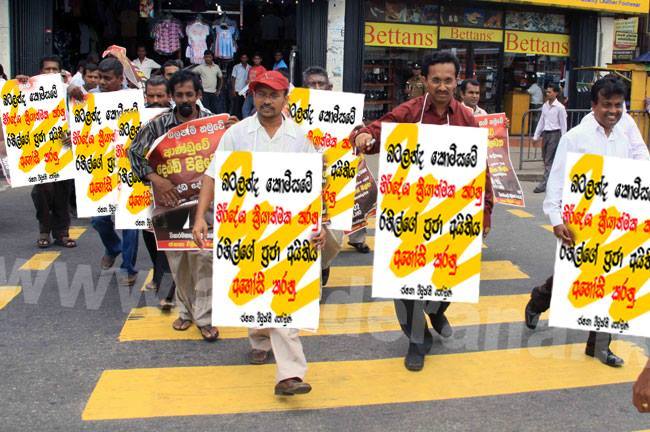 How JVP strongly demanded the implementations of Batalanda Commission.(photo courtesy: TheInternet)
How JVP strongly demanded the implementations of Batalanda Commission.(photo courtesy: TheInternet)
The main suspect in the Batalanda case was ASP (Kelaniya Division) Douglas Peiris whose ASP appointment had not been confirmed since he had failed to pass the necessary examination. On November 25, 1989 Senior SP Nalin Delgoda recommended that Peiris be promoted SP. The letter of recommendation stated that he successfully dealt with subversives during the second JVP insurgency.
On February 6, 1990 the Cabinet approved two salary increments to Peiris. His appointment on July 20, 1988 was made with retrospective effect. This resulted in him being appointed above 130 other police officers in seniority. It was the first time in the Police Department’s history that such a ‘long jump’ in promotions happened.
During this time ‘removing’ was the code word for murder. These killings were called as 55FF deaths. Douglas Peiris admitted that these words meant elimination or destroying. The then IGP Ernest Edward Perera too admitted before the commission that these were extra-judicial killings of subversives. Burning bodies after setting fire to tyres placed on them were called tyre pyres.
Douglas Peiris suddenly vanished and did not appear before commission thereafter. It was later revealed that he had fled the country with a false passport under the name of Thalpawila Kankanamge Wimalasena. Police Inspector P. Nissanka committed suicide by shooting himself shortly before he was to be summoned before the commission to give evidence.
According to the Batalanda Commision report, in addition to Douglas Peiris, Inspector Keerthi Athapattu of the Sapugaskanda Police, SSP Nalin Delgoda (Kelaniya Divsion), DIG Merril Gunaratne (Kelaniya Division), Ranjith Wickremasinghe Officer in Charge of the Anti-Subversion Unit, Kelaniya and Gampaha District MP and Youth Affairs and Employment Minister Ranil Wickremesinghe figured prominently in the Batalanda case.
According to the evidence of DIG Merril Gunaratne special measures had to be taken to deal with the unsual situation which had arisen in the country. It was in 1987 that anti-subversive units were setup in headquarter stations in police divisions. Officers were given the power to travel in mufti in civilian-type vehicles some of which had no registered number plates but only garage numbers. These groups were identified by such names as PRAA (People’s Revolutionary Red Army), Geen Tigers, Black Cats, Yellow Cats and Tarantulas. Their main task was to arrest subversives and destoy them.
Cabinet Minister and UNP MP John Amaratunga told the Commission that in his opinion Black Cats were a police unit. But his Cabinet colleages Ranil Wickremesinghe and Joseph Micheal did not agree with Amaratunga’s view. The words ‘Black Cats’ had been written on the walls of the house occupied by security officers opposite the residence of Douglas Peiris. On Government politician’s intructions about seven housing units of the Batalanda Complex were given for his use, his bodyguards and his office. The rest were occupied by police officers, three of them women – Padmini Premalatha, Kanthi Fernando and Sepalika.
The three escapees from detention at Batalanda, T.M. Bandula, Sugee Perera and Ajith Jayasinghe identified the houses where they had been kept. None of these houses had been acquired by the police following proper procedures. Only the water and electricity bills been paid. These houses had been given to the police on a request Douglas Peiris had made to Ranil Wickremesinghe. Peiris had allowed the police to use the houses the way they wanted.Although the Senior DIG (Adminsitration) had ordered by a circular issued on February 13, 1990 that the houses be given back to their rightful owners it was not done until the end of 1994.
Most cruel and inhuman tortures were inflicted on JVP suspects at Batalanda. These were revealed at the commission hearings by escaped detainees Earl Sugee Perera, People’s Bank Clerk Wasala Jayasekera, Electrician Mudalige Bandula and a Buddhist Monk Bhikku Palipana among other witnesses and Ayurvedic Physician Nimal Attanayake who treated the torture victims.
Evidence revealed that the suspects were blindfolded before being taken to Batalanda where they were stripped and hung by their feet with heads down. They were assaulted mercilessly, chillie powder was put into their eyes and their fingers were pierced with needles. The blindfold and the chains which bound their hands and feet were removed only when they went to the toilet or were given food. At other times they were chained to an item of furniture. They were allowed only one meal a day which was given at 10.00 a.m. On most occasions it was unfit for human consumption. The screams of those who were being tortured were heard continuously. The detainees were lying naked on ground and moaning. Blood was coming out of their wounds caused by being beaten. Some were passing urine with blood.
Some suspects were hung by their hands from the roof. Thereafter they were beaten with clubs. When the victim was screaming in pain pieces of cloth were pushed into his mouth. The beating then resumed.
According to the witnesses some of the victims’ wounds had festered and maggots were found in them. Some had their mouths burnt. A couple of suspects had their hands and legs tied together after making them bend over a pole fixed horizontally. The victim was then turned like a wheel while being hit on his toes with clubs. This was euphemistically called the ‘Dharma Chakra’ treatment. Others were burnt with cigarette butts.
Some were taken out along roads in the surrounding areas after forcing them to wear hoods to prevent identity. They were then ordered to show JVP suspects. Others were ordered to do the same after forcing them to wear female attire and wigs. The hooded men were called ‘goni billas.’ At any given time over 100 persons were detained at the Batalanda complex. The persons taken out were never brought back to the housing complex. Some detainees had been released only after a bribe of around Rs.50,000 had been paid by his relatives to a person whom the torturers had named.
Bhikku Palipane of Manelwatte Vihara was arrested on January 31, 1989 and detained at Batalanda where he was stripped before being kicked and made to suffer burns. Testifying before the Commission he identified Woman Police Sub-Inspector Padmini Premalatha as one of those who tortured him.
JVP activist Attorney Wijedasa Liyanarachci was tortured at the residence of Tangalle SP Karawitage Dharmadasa after being abducted at Nugegoda on August 25, 1988 at 4.00 p.m. Following protests by his associates he was brought to Colombo on September 1, 1988 at 11.30 a.m. and detained at the Sapugaskanda Police station under the custody of the Kelaniya special police unit operating from Batalanda.
The judicial inquiry into his death began in December 1989 before a bench of three High Court Judges. Before the verdict was delivered in 1991 the accused unexpectedly admitted they were guilty of abducting and illegally detaining Liyanarachchi. They were given only suspended jail sentences. Later it was revealed that Liyenarachci had been tortured to death at an undsclosed location. The Batalanda Commission’s view was that only those responsible for the crime would have the answer to the question whether he was actually killed.
The JVP’s armed wing attacked the Sapugaskanda Police Station on July 16, 1989 at 2.55 a.m. and escaped with several weapons. However the police killed two of the attackers. One of the dead was Sumith Perera alias Kaluwa. The following year on February 20 at 8.30, OIC (Crimes) Sapugaskanda Police Rohitha Priyadarshana dissappeared. His body was found floating in the Kelani River on February 23. The OIC, Sapugaskanda Police at the time was Keerthi Athapattu. When Sub-Inspector Ajith Jayasinghe of the Ja-ela Police opposed abductions he himself was abducted under the direction of Douglas Peiris near the Dematagoda Railway Crossing on February 24, 1990 and detained illegally.
Two brothers Udayachandra and Ratnachandra who resided at ‘Amba Sewana’ Kanduboda in Delgoda were abducted on July 7, 1989 and detained at the Batalanda Housing Complex. This resulted in a Habeas Corpus to the Appeals Court. Ratnachandra had been killed under detention. Udayachandra who escaped from the custody of his abductors gave evidence at the judicial inquiry. Gampaha High Court Judge Saman Wickremarachchi who heard the case sentenced Douglas Peiris and four other police officers on August 26, 2009 to five years rigorous imprisonment.
According to the Batalanda Commission the only conclusion one could arrive at about the matters discussed at Batalanda was that they were illegal. Noting that Ranil Wickramesinghe had advised the police on dealing with public meetings convened without permission, the Commission stated that he had no legal authority to give such instructions to the police and therefore he had abused his position. The Commission was of the view that this issue was connected with the running of illegal detention centres and torture chambers at the Batalanda.
There was no question that ASP Douglas Peiris, Chief Inspector Ranjit Wickremasinghe and other officers of the Kelaniya Anti-Subversive Unit were directly responsible for the running of illegal detention centres and torture chambers, as the Commission stated.
Wasantha Kulatunga of the Presidential Media Unit, who first videoed the Batalanda Torture Chamber, had handed over the video tape to the President Chandrika Kumaratunga’s media advisor. But when the Government Analyst visited the scene all the blood stains on the floor and walls of the torture chamber had been wiped off.
The Commission had further stated that no matter the violence the JVP unleashed in an attempt to cripple the state the government should have acted with responsibility. The Government should have responded in accordance with the law and accepted rules of governance.
The Batalanda events is only one example of political meddling during the period in question, going by the relevant report, according to the Commssion. Some politicians of the ruling party not only actively participated in police operations but had also directed them.
The Commission also recommended in its report that the Supreme Court be given additional powers to deprive the civil rights of persons – including a Government politician – identified as those who repeatedly violated fundamental human rights. The Commission stated that judicial procedures had been repeatedly violated with impunity. Some individuals representing the Executive had continued to violate fundamental human rights without fear of punishment.
The Batalanda Presidential Commison’s Report was handed over to President Chandrika Kumaratunga on March 27, 1998. Although the the time for handing over the report had been fixed 5.30 p.m. the President arrived only at 8.30 p.m.
If anyone asks why was there no follow up action on the recommendations made by special commissions appointed by six Presidents the answer would be that the commissions were meant to politically hoodwink the public. The past Presidents referred to had wittingly or unwittingly shirked their responsibility of enforcing the law on the recommendations made.(The writer is a senior journalist who could be reached at ejournalists@gmail.com)
By Dharman Wickremaratne
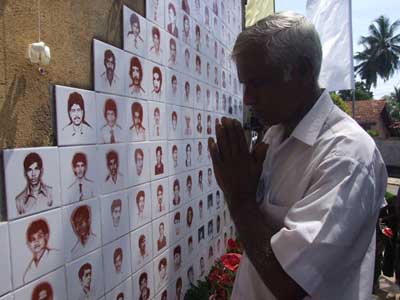
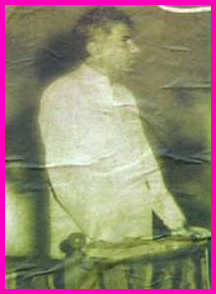
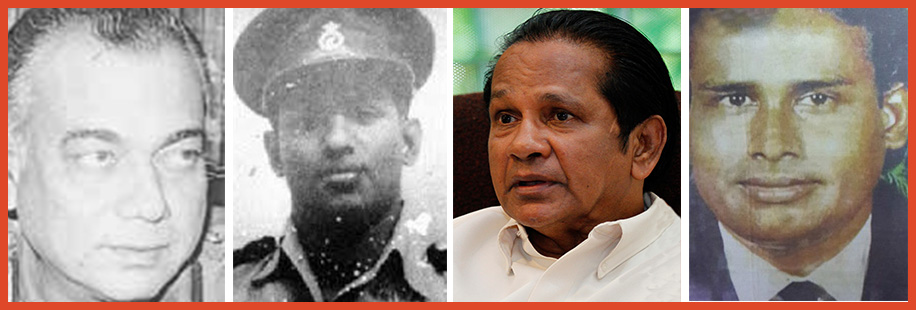
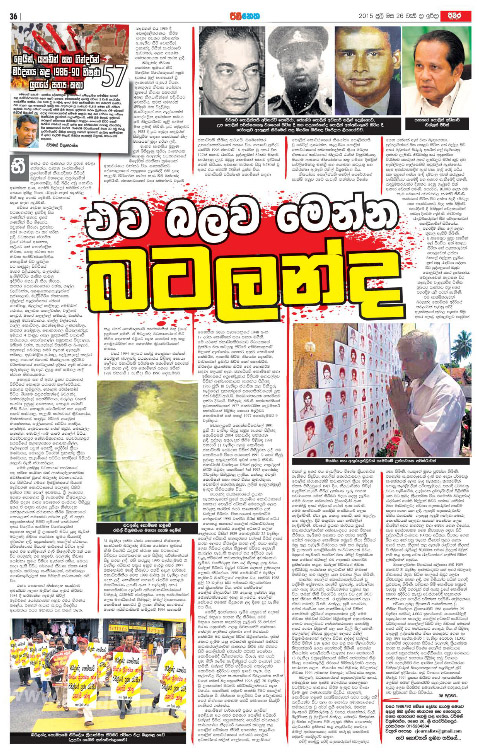
December 29th, 2017 at 5:00 pm
The most important thing in all these is that no Indian Colonial Parasite names do not appear. The JVP was the and is the Sinhala terrorist arm of India. India’s genocide of Sinhalese continue.
December 30th, 2017 at 2:34 am
Not only the Batalanda Wdhakaya but also the JVP is responsible for these unncessary deaths.
December 30th, 2017 at 5:48 am
Not surprisingly just 2 comments. When jaathidhrohee vermins’ party aka jvp supporters themselves don’t care
about these poor victims, who is going to shed a tear.
What do you get when catholic police top brass + Sinhalese cannon foder = A Sinhalese cull! 60,000+.
Not bad for the C brigade? Not bad at all. Mostly Sinhalese younger generations. Seed pods you could say.
Rehabilitation? What rehabilitation? They were Sinhalese. So no mercy from the catholic run UNPatriotic party
spearheaded by traitor chief die hard catholic token Buddhist Mega Thief Mega Thakkadiya Bay Gal Karaya Lajja
Baya Nathi Aga Matta Batalande Wadakaya Pol Pot r@nil wickrama Sinhala killer with his top catholic police brass.
So the killing, torture went on and on. If you want someone eliminated, just say he/she is a jvper, job done. 6 years! Sirima B took just 2 weeks. Most of them were rounded up, rehabilitated and realsed back to the society.
But catholic run UNPatriotic party took 6 years and got rid of 60,000+. Still Sinhala modayas were clueless.
How did the UNPatriotics fought the real terrorists, catholic tigers of tamil drealam? They kept sacrificing Sinhalese
tri forces personnel, police, Buddhist monks, men, women and children. Another 100,000+ gone. Punishment for
the traitor low lives? What punishment? Bandit queen just turned a blind eye to the work of the Destroyer in Chief
Batalande Wadakaya. Traitor old hag didn’t want to upset
its catholic buddy Batalande Wadakaya. So the Wadakaya was let off the hook to do more and more damage to
Buddhism, Sinhalese race and Sri Lanka. A lot of Sinhalese has been not just modayas, they have been dhrohiyas
to support this anti Buddhist, anti Sinhalese and anti Sri Lankan catholic run UNPatriotic deshapaluwans. Now traitor
low lives are prepared to do the biggest treachery by breaking up Sri Lanka to please its ardent supporters tamils,
mussies, catholics and the catholic west! Who is at the forefront of all this? It is of course the cancer in Mother
Lanka, Batalande Wadakaya!
December 30th, 2017 at 5:57 am
Following links explains why Buddhist jvpers were burnt in tyres, headless corps in rivers etc. while catholic tigers
of tamil drealam were given half the country by barrel man hitler mala paharan’s catholic buddy traitor chief
die hard catholic token Buddhist Mega Thakkadiya Mega Thief Bay Gal Karaya Batalande Wadakaya Lajja Baya
Nathi Aga Matta Pol Pot r@nil wickrama Sinhala killer. Sri Maha Boddhi massacre, Aranthalawa Bhikku massacre,
Sri Dalada Maligawa attack, Denzil Kobbekaduwa murder etc. etc. still no action from the UNPatriotics. You won’t see these in so called Buddhist Sri Lanka (on paper of course) where all the media chiefs are Batalande Wadakaya’s henchmen! Hope a media man like
Dharman W can publish some of these articles in a Sri Lankan news paper. People can only see the the true
colours of this catholic run UNPatriotic party online only. This gives the traitor low lives to hoodwink Sinhala
modayas again and again.
http://www.lankaweb.com/news/items/2016/05/27/ranil-wickremasinghes-new-unp-3/
http://www.lankaweb.com/news/items/2017/08/09/ranil-wicremasinghes-crimes-against-sri-lanka-and-its-people-for-forty-years/
http://ltte-christian-ties.blogspot.com/
https://www.youtube.com/watch?v=cV6_o9txURc
http://www.lankaweb.com/news/items/2015/08/05/christianizing-of-sri-lanka-unps-betrayal-of-buddhism/
http://www.lankagrid.com/soma-thero/
https://www.youtube.com/watch?v=V_eJ1gX_fuU
http://www.lankaweb.com/news/items/2016/09/26/ltte-terrorism-church-links-can-someone-explain-these-photos/
January 1st, 2018 at 12:04 pm
Lorenzo is a dangerous person. He writes something when he really means some thing else. He is the one who said that Gotabhaya should take over power. He said the Armed Forces should be given power . All that was to warn President Sirisena to be careful of them- GR and the Armed Forces. Now Sirisena- Ranil Yahapalanaya is after Gotabhaya’s blood . They want to arrest him. See the Lorenzo who is being brough to the fore front by Lanka web is like